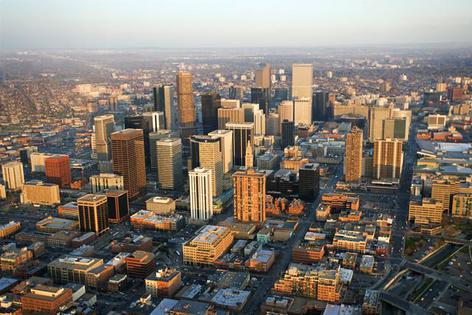Map: © OpenStreetMap contributors
Another Ed Sadowski creation
ED SADOWSKI
Stage & Screen
Airports...Archaeology...Architecture...Art...Beer, Wine, Pubs... Bookstores...Bridges, Tunnels, Dams...Churches, Religion... Cities... Dinosaurs... Education...Events, Festivals...Food, Restaurants..Hotels... Libraries... Manufaturing...Health, Medicine...Mountains, Nature... Museums... Music...News media...People...Publishing...Races, Rallies, Parades...Radio, TV...Rail transit...Retail...Rivers, Lakes, Hot Springs...Sports...Stage, Screen...Streets, Highways, Infrastructure... Urbanism...Weather, Climate
Downtown
Denver
STAGE & SCREEN
Boettcher Concert Hall
Buell Theatre
Centre Theatre
Denver Center for the Performing Arts (DCPA)
Denver Municipal Auditorium Arena
Denver Performing Arts Complex (DPAC)
El Chapultepec
Elitch Gardens
Ellie Caulkins Opera House
Eugenia Rawls Courtyard Theatre
Paramount Theater
Tabor Grand Opera House
Boettcher Concert Hall /////////////////////////////////////
14th and Curtis
Boettcher Concert Hall is the nation’s first symphony hall in the round, designed to place the audience close to the stage in a unique environment: 80% of the seats are within 65 feet of the stage. The hall’s 360-degree surround concert design ensures no member of the audience is more than 85 feet from the stage, providing an intimate atmosphere while maintaining traditional symphonic sound quality. The Colorado Ballet was the world’s only ballet company to play in a concert hall in-the-round, at Boettcher Concert Hall.
The Concert Hall is part of the Denver Performing Arts Complex and is home to the Colorado Symphony. The Colorado Symphony Orchestra was the first in the US to be musician-operated. Boettcher seats more than 2,700, in five kinds of seating areas: the dress circle, orchestra seats, mezzanine seats, the parquet section adjoining the stage, and the overhead rings which float over the lower seats.
Built in 1987, the theatre underwent a major acoustical renovation in 1993: the height of the seat backs were adjusted, additional acoustical reflectors were added, and acoustic curtains were installed, which allow the theatre to be tuned for specific performances.
The Hall is named after Charles Boettcher (1852-1948), Colorado business magnate and founder of the philanthropic Boettcher Foundation.
Buell Theatre ///////////////////////////////////////////////////
14th and Curtis
The Temple Hoyne Buell Theatre is one of the nation’s top venues for traveling Broadway shows, plays and comedy acts. It is continuously ranked as the highest-grossing theatres of its size in the country, with over half a million yearly attendance.
The Buell Theatre (seating capacity 2,830) is the largest and most versatile part of the Denver Performing Arts Complex (DPAC). The theatre is named after distinguished architect Temple Hoyne Buell. The theatre is within the outer walls of the former Denver Municipal Auditorium and Arena, originally constructed in 1908. After the Arena was demolished in 1990, the Buell Theatre opened in its space in 1991.
The theatre’s house interior is lined with around 8,000 pieces of gray and pink sandstone from Lyons, some of which contain fossils. Three hundred loudspeakers are located throughout the house. The height of the ceiling was determined partly to accommodate the Phantom of the Opera chandelier, a major prop for the show’s first national touring production and the first touring Broadway show to perform in the Buell.
Centre Theatre ////////////////////////////////////////////////
16th and Cleveland
GONE INTO HISTORY
The first movie theater in the world "designed expressly for CinemaScope and stereophonic sound,” was how the Centre Theatre's 1954 opening on 16th Street was hailed.
It was downtown's first new movie house since 1932. The cinema boasted a 28-foot high, 60-foot wide curved Cinemascope screen, adjustable to fit any format. No more conventional overhanging balcony, but stadium-style seating, with a raised stepped section at the rear. The theater seated 1,247, and the elaborate lobby had a columbine-decorated terrazzo floor. Gold and silver leaf plasterwork adorned both the lobby and auditorium. The massive green, gold, pink and silver marquee lit up 16th Street in spectacular fashion, standing 60 feet wide and 100 feet tall.
Opening night in the new $1 million dollar cinema was marked by the world premier of "River of No Return," starring Marilyn Monroe and Robert Mitchum. This special evening's festivities was a dazzling, star-studded Hollywood affair. Mistress of ceremonies was Ethel Merman, who lived in Denver at the time, and welcoming speaker was Denver Mayor Quigg Newton. Present were Mary Pickford, Charles Coburn, Dale Robertson, Dan Daily, Tex Ritter, Rita Moreno, Forrest Tucker and Robert Wagner. Before the "waterfall" curtain was swept back for the screening, the audience was treated with live performances on the stage by songs by Merman and Ritter as well as softshoe dancing by Dailey. Mayor Quigg Newton
Built by Fox Intermountain Theaters, The Centre was sold in 1976 and leased to Mann Theatres. It was sold again in 1980 to Larken Development Group of Calgary. The theater was torn down in 1981 and Columbine Place built on its location, standing between the Sheraton Hotel and McDonald’s at the head of the 16th Street Mall.
Denver Center for the Performing Arts (DCPA)
14th and Curtis
Founded in 1972, the Denver Center for the Performing Arts Complex is the nation’s largest non-profit theatre organization—and the second largest performing arts complex in the world after New York City’s Lincoln Center.
The DPCA is a four-block, 12-acre site containing ten performance spaces with over 10,000 seats connected by an 80 ft. tall glass roof. It is home to a Tony Award-winning theatre company, Broadway touring productions, contemporary dance and ballet, magnificent chorales, a major symphony orchestra, internationally-acclaimed opera and more.
The three largest theatres in the complex are Boettcher Concert Hall, the Ellie Caulkins Opera House and the Buell Theatre. In addition there are half a dozen smaller theatres and a grand ballroom. These facilities are home to the Colorado Symphony, Opera Colorado and the National Theatre Conservatory.
The DCPA hosts and partners with the oldest and largest student Shakespeare festival in the country, where 5,000 Denver Public Schools students perform on stages in the DCPA complex.
Denver Municipal Auditorium Arena /////////////
14th and Curtis
GONE INTO HISTORY
The Denver Municipal Auditorium was constructed in 1908 and was the site of the 1908 Democratic National Convention. With a capacity of 12,500, at the time of its opening was the second largest venue of its type in America next to Madison Square Garden.
In 1921 a full-length opera was broadcast on radio from the Municipal Auditorium, a world first. The Auditorium was the main venue for Denver opera for 75 years. The facility was expanded in 1953, adding the 6,841-seat Denver Auditorium Arena to the southwestern part of the building. Until McNichols Arena opened in 1975, the Auditorium Arena was the primary indoor location for professional sporting events and concerts. In 1968, the rock group Led Zeppelin played their first American concert at the Arena.
In 1974 Denver Post publisher Donald Seawell was inspired with a plan to rebuild the facility into what is now the Denver Performing Arts Complex. The Arena was demolished in 1990 and reopened as the Temple Hoyne Buell Theatre in 1991. In 2005 the Auditorium was rebuilt into the Ellie Caulkins Opera House.
Denver Performing Arts Complex (DPAC) //////
14th and Curtis
The DPAC is the world’s largest performing arts complex under one roof, and the second-largest after New York’s Lincoln Center in terms of number of venues and seating capacity. It is operated by Denver Arts and Venues and the Denver Center for Performing Arts (DCPA), the nation’s largest theatre non-profit organization.
DCPA was founded in 1972 by Donald Seawell, distinguished lawyer, theatrical producer and publisher of The Denver Post. The DPAC is a four-block, 12-acre site containing ten performance spaces with over 10,000 seats connected by an 80 ft. tall glass roof. It is home to a Tony Award-winning theatre company, Broadway touring productions, contemporary dance, magnificent chorales, the Colorado Symphony, Opera Colorado, Colorado Ballet and more. It was the home of the acclaimed and defunct National Theatre Conservatory.
The three largest theatres in the complex are Boettcher Concert Hall, the Ellie Caulkins Opera House and the Buell Theatre. In addition there are half a dozen smaller theatres and a grand ballroom. The DPAC hosts and partners with the oldest and largest student Shakespeare festival in the country, where 5,000 Denver Public Schools students perform on stages in the DPAC complex.
El Chapultepec ///////////////////////////////////////////////
20th and Market
How many jazz joints can claim President Clinton played his tenor saxophone there? It happened at El Chapultepec, the oldest jazz club west of New Orleans, and one of the most revered nationally.
The unassuming building has been around since the late 1890s, but opened as a bar in 1933, the day after prohibition ended. In 1967 jazz was introduced there by the late owner Jerry Krantz, who grew up around jazz in Chicago.
El Chapultepec has become a jazz club known across the country as a jazzman’s bar, where many stars play after performing in more traditional venues in the area. The “Pec” has been known as a place where music legends have payed homage to it with impromptu visits: Frank Sinatra, Tony Bennett, Ella Fitzgerald, Woody Herman, Artie Shaw, Count Basie, as well as rockers like Paul McCartney and Mick Jagger. Their pictures line the walls of this intimate, nostalgic place that hasn’t been remodeled since 1951—“a true neighborhood jazz club,” as Wynton Marsalis has put it. El Chapultepec “smells like New York, feels like New Orleans, and sounds like southside Chicago,” one reviewer wrote of the Pec.
Elitch Gardens //////////////////////////////////////////////
North Denver, then Platte River Valley
Elitch Gardens is America’s only downtown area theme and water park. Located, since 1995, in the Central Platte River Valley, it is 65 acres in size, consisting of 53 rides (six roller coasters, two water rides).
Elitch Gardens was founded by John and Mary Elitch in 1890 in north Denver’s West Highland neighborhood, and became nationally-known as a family-owned amusement park, theater, symphony orchestra and botanic garden.
The Elitch Theatre, modeled after Shakespeare’s Globe Theatre in London, became the state’s first cinema, and, from 1893 to its closing in 1991, became known as the country’s first and oldest summer stock theatre, later attracting Hollywood stars. The great Trocadero Ballroom was the ultimate date night destination for dancing and famous big bands, with weekly national radio broadcasts, but was torn down in 1975. Elitch’s also had the third-oldest zoo west of Chicago, operating until the 1930s, many of the animals initially donated by P.T. Barnum. After her husband’s death in 1891, Mary Elitch became known as the first woman in the world to manage a summer resort and zoo.
Elitch’s first carousel, added in 1906, is the second-oldest operating carousel west of Chicago, now located in the town of Burlington. Elitch’s Mister Twister wooden roller coaster, operating from 1964 to 1994, was regularly rated as the one of the top ten rides in the country. A long-standing slogan of the amusement park had been, “Not to see Elitch’s is not to see Denver.”
Ellie Caulkins Opera House ///////////////////////////
14th and Curtis
“The Ellie,” home to Opera Colorado and a venue for the Colorado Ballet, and former home to the Colorado Ballet, is the most acoustically-advanced opera house in the world.
It opened in 2005 inside the space of the former historic Denver Municipal Auditorium, in the Denver Performing Arts Complex. The Ellie was designed in the classic lyric style, Inspired by many of the world’s greatest opera houses, with four levels: balcony, loge, mezzanine and orchestra. Its first-ever innovation of a moveable wall behind the orchestra and the stage adjusts and optimizes the sounds of the orchestra. The Ellie is one of only three opera houses in the United States, one of nine world-wide, with seatback titling at every seat in the house, with a seating capacity 2200-plus. The Ellie is graced with notable public art, including a Dale Chihuly artwork, a magnificent chandelier that is a one-of-a-kind glass sculpture.
The opera house is named after Eleanor Caulkins, a key figure in the founding of Opera Colorado in 1983, and whose family has been a major donor to the facility’s cost.
Eugenia Rawls Courtyard Theatre ////////////////
Auraria Higher Education Center, Central Platte Valley
The Rawls Theatre is one of three of-its-kind in the world, being the only facility in America designed as three theatre spaces in one. The theatre is part of the King Center for Performing Arts, constructed in 2001.
The venue can be configured as follows: a thrust theatre (also known as a platform stage or open stage), extending from the backstage area into the audience on three sides; a theatre-in-the-round, where two pivoting seating towers rotate onto the thrust stage to create the theatre-in-the-round; and a traditional proscenium arch stage (Broadway style), reminiscent of an old opera house. Three seating levels handle up to 268 people, depending on configuration. This is the only space in the US, at this time, providing access to the catwalk for persons with disabilities. Each college ( has its own studio theatre (Black Box) Most unusual is a scene shop and costume shop is shared by the three colleges on the Auraria campus.
The theatre is named after actress Eugenia Rawls (1913-2000), wife of Donald Seawell, founder and chairman of the Denver Center for the Performing Arts.
Paramount Theater /////////////////////////////////////
16th and Glenarm
The Paramount Theatre has the rare musical treasure of a twin set of Wurlitzer organs, found only in one other venue, Radio City Music Hall in New York City.
The glamorous 16th Street art deco movie house opened in 1930, has survived the demise of downtown cinemas, and is now a thriving multi-event entertainment facility. With its original architectural and design elements the theatre is listed on the National Register of Historic Places.
The Paramount was designed by Denver architect Temple Buell with Chicago theatre designer Rapp and Rapp. Buell is credited with founding the “western style” of architecture as well as the concept of the modern shopping mall. Buell cited the Paramount and its housing in a three-story office building facing Glenarm Place as the finest example of his work.
Over 7,000 organs were installed around the world from 1915 to 1933 to provide music and sounds to accompany silent movies, but fewer than 40 instruments remain in their original venues. The Denver Paramount’s organs, rising just beyond the theatre’s footlights, are just one of just three of 18 Publix 1 cinema organs still in their original venues. The Paramount double-console Wurlitzer has four manuals (keyboards) and its 20 ranks (sets of pipes, at least 61 pipes for each rank) is numerically in the top ten of all vintage organs in North America.
Tabor Grand Opera House /////////////////////////////
nw corner of 16th and Curtis
GONE INTO HISTORY
The Tabor Grand Opera House was the most opulent building, the finest theatre between Chicago and San Francisco when it was built in 1881 by Horace Tabor for the then phenomenal sum of $850,000. Tabor, the silver king who had amassed a fortune in Colorado’s mines (the most famous known as the Matchless), built an opera house in Leadville, then in Denver, bringing world-class culture to the new Queen City of the Plains.
Tabor dabbled in politics and had many business ventures, and at his height was the fifth richest man in the country. He scandalously married for the second time, to a much younger “Baby Doe,” their storied life together becoming the subject of an opera, movie, play and novel.
The collapse of silver in the Panic of 1893 as well as risky investments wiped out Tabor’s fortune. In 1921 the Opera House was extensively remodeled, becoming a movie palace. At this time the largest steel girder ever installed in a public building, was put into place to hold up the weight of most of the balcony. The theatre attracted the biggest names in entertainment as well as plays. Increasingly the theatre’s operation was not sustainable, and the building was torn down in 1964. The site is now occupied by the Denver branch of the Federal Reserve Bank of Kansas City.



